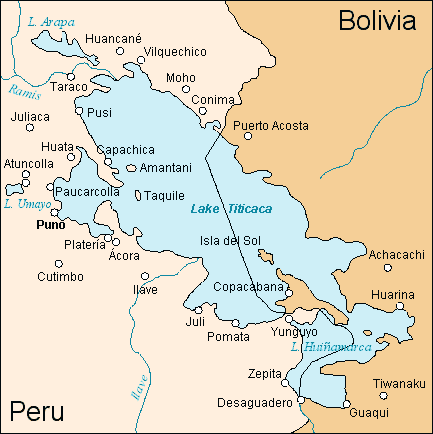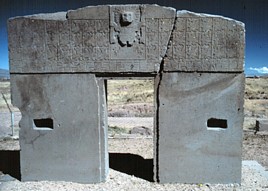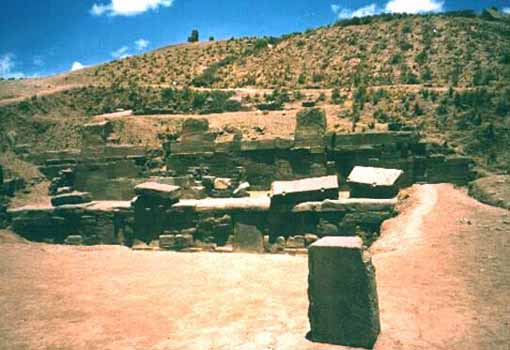By Gene D. Matlock
If Westerners would admit that many thousands of years ago, the world before Noah and the Great Flood was vastly different than it is now, many mysteries could be cleared up. One such mystery is the enigma of the ruins of Tiwanaku lying on the border of Bolivia and Perú. Between 10 to 20 thousand years ago, Tiwanaku was in its glory. But now, the massive fallen stones which were used to build this massive city lie scattered about, having at one time been tossed about just like popcorn in a skillet. The stones are so large that even today, it would be a technological marvel to take them from the mountainous quarry they were brought from, fifty miles away.

Lying close to Lake Titicaca, these ruins lie at approximately 13,000 feet above sea level. It appears certain that it was once a seaport. It still has the ruins of extensive docks lying on an earlier shoreline. In Tiwanaku's heyday, one of these docks could have accommodated hundreds of sea-going vessels!
Although Tiwanaku is far from being adequately excavated, estimates are that it could have had between 40,000 and 100,00 inhabitants.
Lake Titicaca is the highest navigable lake in the world. It was at one time much larger than it is now. Its shoreline once extended to Tiwanaku.
 Tiwanaku appears to derive from Sanskrit: Diva(heaven; sky) plus Naka (mountain). Its original name also could have been Deva (heavenly; deity; god) plusNaga (serpent). The word Tiwa could also have derived from the ancient Siberian-Turkic nation of Tannu-Tiva, a.k.a. Tannu-Tuva (the biblical Tubal). Even there, Tiva, Teva, or Tuva referred to the sun or the sky.
Tiwanaku appears to derive from Sanskrit: Diva(heaven; sky) plus Naka (mountain). Its original name also could have been Deva (heavenly; deity; god) plusNaga (serpent). The word Tiwa could also have derived from the ancient Siberian-Turkic nation of Tannu-Tiva, a.k.a. Tannu-Tuva (the biblical Tubal). Even there, Tiva, Teva, or Tuva referred to the sun or the sky.
If the natives living near Tiwanaku gave the name Kalasaya to the mound atop which lies the impressive Portal of the Sun, we have further proof of a previous Hindu-Turkic presence in Tiwanaku. This word is similar to the Sanskrit Kailasa, the mountain of Kubera and Shiva (Meru).
 In Sanskrit, Eka-apana means "Principal" or leading market, trade, or commercial center. Was the Akapanapyramid a big trading center?
In Sanskrit, Eka-apana means "Principal" or leading market, trade, or commercial center. Was the Akapanapyramid a big trading center?
There is evidence that Titicaca was once a saltwater sea. Its shoreline is littered with millions of fossilized seashells. The marine fishes and seahorses in the lake are all oceanic types found only in salt water.
Researchers are convinced that these 3 miles high ruins once lay at sea level. Therefore, an incredibly devastating earthquake could have torn the city asunder, lifting Tiwanaku and the lake to where they are now. How can this be proven? The answer lies in the name of Lake Titicaca itself-linguistic proof no one can deny and in two of the most ancient languages in the world: Sanskrit and Tamil. The word Titicaca has no meaning any of the Andean languages.
In Sanskrit, the word GaGga, (GAHG-gah) means "river," but not just any river. It means a river as sacred as or related to the Ganges.
In Tamil, it is KaGkai (KAHG-ky), meaning the same as the above.
In Sanskrit, Diti was the wife of the god Kasyapa (sea tortoise). Titi is the Tamil equivalent. Therefore, Titikagkai=Ditigagga=Titicaca.
What was Titicaca at one time? Has it always been just a freshwater lake with saltwater fauna? Or was it a great and sacred river flowing at nearly sea level, and leading to the sea?
See also Tiahuanaco: Gateway to the Gods - previous Viewzone article.
No comments:
Post a Comment